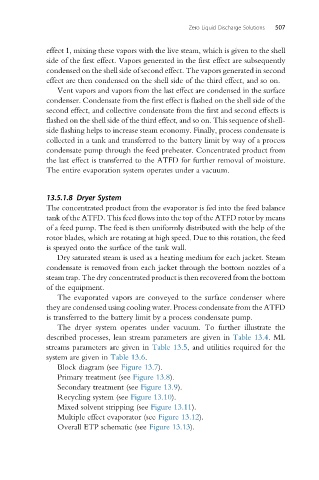Page 537 - Industrial Wastewater Treatment, Recycling and Reuse
P. 537
Zero Liquid Discharge Solutions 507
effect 1, mixing these vapors with the live steam, which is given to the shell
side of the first effect. Vapors generated in the first effect are subsequently
condensed on the shell side of second effect. The vapors generated in second
effect are then condensed on the shell side of the third effect, and so on.
Vent vapors and vapors from the last effect are condensed in the surface
condenser. Condensate from the first effect is flashed on the shell side of the
second effect, and collective condensate from the first and second effects is
flashed on the shell side of the third effect, and so on. This sequence of shell-
side flashing helps to increase steam economy. Finally, process condensate is
collected in a tank and transferred to the battery limit by way of a process
condensate pump through the feed preheater. Concentrated product from
the last effect is transferred to the ATFD for further removal of moisture.
The entire evaporation system operates under a vacuum.
13.5.1.8 Dryer System
The concentrated product from the evaporator is fed into the feed balance
tank of the ATFD. This feed flows into the top of the ATFD rotor by means
of a feed pump. The feed is then uniformly distributed with the help of the
rotor blades, which are rotating at high speed. Due to this rotation, the feed
is sprayed onto the surface of the tank wall.
Dry saturated steam is used as a heating medium for each jacket. Steam
condensate is removed from each jacket through the bottom nozzles of a
steam trap. The dry concentrated product is then recovered from the bottom
of the equipment.
The evaporated vapors are conveyed to the surface condenser where
they are condensed using cooling water. Process condensate from the ATFD
is transferred to the battery limit by a process condensate pump.
The dryer system operates under vacuum. To further illustrate the
described processes, lean stream parameters are given in Table 13.4.ML
streams parameters are given in Table 13.5, and utilities required for the
system are given in Table 13.6.
Block diagram (see Figure 13.7).
Primary treatment (see Figure 13.8).
Secondary treatment (see Figure 13.9).
Recycling system (see Figure 13.10).
Mixed solvent stripping (see Figure 13.11).
Multiple effect evaporator (see Figure 13.12).
Overall ETP schematic (see Figure 13.13).

